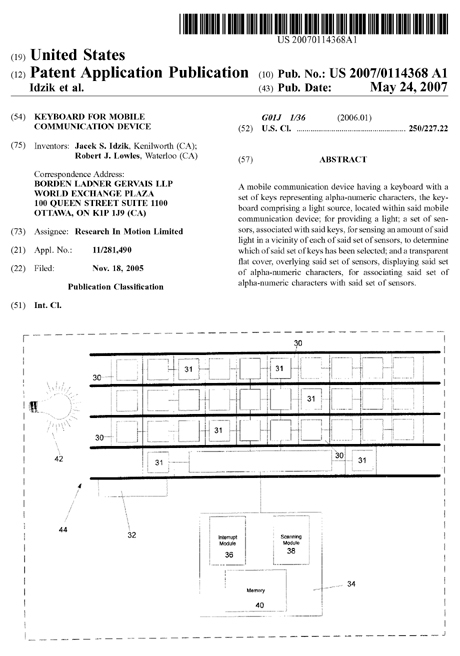BlackBerry patent app describes keys lit as they are tapped

Just published this morning, a new BlackBerry Patent application describes technology that would light individual keys on a BlackBerry keyboard when the user taps that key.
The Patent app bears a surprisingly generic title: Keyboard for mobile communication device. Only when we read the Abstract and then Figure 2 with its accompanying text, do we get a real good idea of what is being explained here.
First, let us learn what the Abstract calls for:
A mobile communication device having a keyboard with a set of keys representing alpha-numeric characters, the keyboard comprising a light source, located within said mobile communication device; for providing a light; a set of sensors, associated with said keys, for sensing an amount of said light in a vicinity of each of said set of sensors, to determine which of said set of keys has been selected; and a transparent flat cover, overlying said set of sensors, displaying said set of alpha-numeric characters, for associating said set of alpha-numeric characters with said set of sensors.
We get an even better idea of what is being proposed as we go to Figure 2 and its associated text.
FIG. 2 provides a schematic view of a keyboard within the mobile communication. The mobile communication device 10 further comprises a light source 42, preferably an infra-red light source, which provides the necessary light for operation of the keyboard (as will be described in more detail below) along with a set of infra-red sensors 30, each associated with one of the keys 25 of the keyboard and a piezo-transducer 32 which is associated with the set of infra-red sensors 30 to provide a tactile response to the user when they press the key. By having only a single transducer, this assists in decreasing the size and weight of the device and helps the simplicity of the internal set up of the device.
Each of the sensors 30 includes a corresponding filter 31, preferably a bandpass filter, which assists in sensing the light from the light source 42. Each bandpass filter 31 is preferably separate from, but associated and in communication, with one of the set of sensors 30. However, the bandpass filter 31 and the sensor 30 may also be provided as a sensor and bandpass filter combination. In the preferred embodiment, by using a bandpass filter, only selected frequencies of the infra-red light are sensed by the sensors 30 and ambient light does not interfere with the readings of the sensors 30.
Each of the rows of sensors are located in a light pipe 44 which receives the light from the light source 42 and directs the light towards each of the sensors 30 which are preferably connected to, and in communication with, a processor 34 (within the mobile communication device 10) which processes the keys which are being pressed. The processor 34 preferably comprises an interrupt module 36, a scanning module 38 and a memory 40.
As shown in FIG. 3, in operation, infra-red light from the light source 42 is transmitted along the light pipe 44 and is reflected off the light pipe 44 by bouncing off the bottom of the keyboard (cover 26) and the borders of the keys until the light reaches an opening 46 (which represent the keys 25 of the keyboard 23).
The sensor 30 located underneath each of the openings sense the amount of infra-red light in its immediate vicinity as the ambient light is filtered out by the bandpass filters 31. When there is no finger of object covering the opening, the sensor 30 only senses an expected, or default, value of light and therefore concludes that the key associated with the sensor 30 has not been selected.
It will be understood that each of the sensors has a threshold infra-red light value (representing the expected value) but once this threshold is passed (indicating the presence of a finger), the sensor transmits a signal, such as an interrupt signal, to the processor 34.
When a finger is placed over the opening 46, the presence of the finger deflects the infra-red light towards the sensor 30 so that the sensor 30 senses the increase of infra-red light (above the threshold value).
Each time a key is pressed, the piezo-transducer 32 provides a tactile response to the user to recognize that a key has been pressed.
